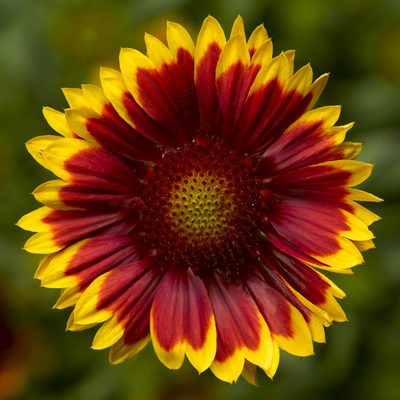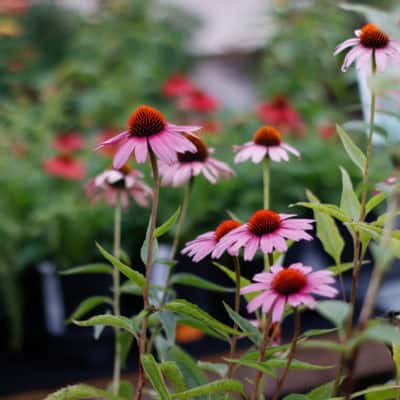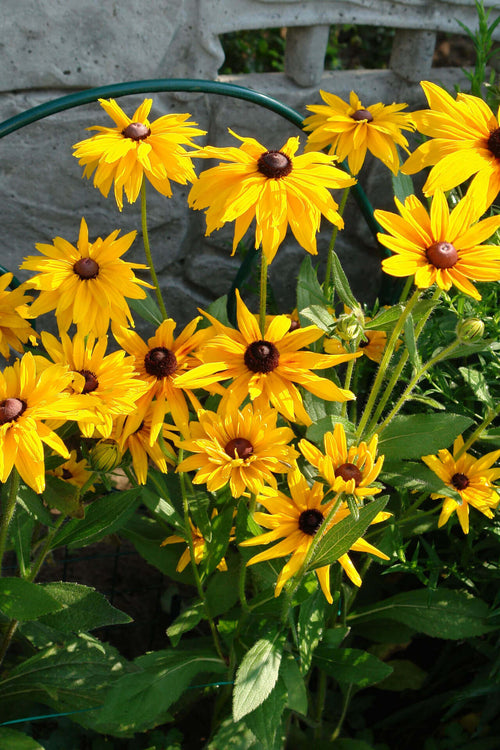Living Art- How to Choose Color in a Garden
Choosing colors for a garden should be fun, not work. However, with so many choices out there, a person can become easily confused.
Coordinating flowers is about more than just picking a color. A garden should express visual symmetry and balance. The secret to creating beautiful spring and summer displays is to plan.
When taking a tip from interior designers, the color wheel is an easy way to arrange a garden. That is an abstract circular illustration of how primary and secondary colors relate to each other. A scheme is created by combining hues according to set principles. Choosing a color in a garden is either contrasting or harmonious.

Contrasting Garden Color
Contrasting colors are located across from each other on the color wheel. Using these bold combinations can result in a striking effect. This technique can be used with groups of plants next to each other. Here are the possible scenarios when using contrasting colors:
Use two complementary colors opposite each other on the color wheel—for example, groups of purple and yellow flowers or orange and blue flowers. Dwarf plant varieties can create a carpet of one color in the front, then taller blooms of the complementary color in the back. That results in a sophisticated-looking landscape.
Polychromatic schemes use a riot of color that can be very pretty if done well. The problem is that it is difficult to do this without it looking too busy. That works best with an old-fashioned cottage-style property.
Harmonious Garden Color
Harmonious colors are the ones that are beside each other on a standard color wheel. They can include any colors that similarly reflect light. Yellow and orange are harmonious colors, as are purple and blue.
An example of this in the landscape is a monochromatic color theme. In this instance, a single color is used throughout the garden. The various shades and hues of that color are incorporated. For example, white is a common monochromatic theme. The flowers may be a mix of snow-white, cream, or eggshell. This look is exquisite and contemporary.
Garden color doesn’t have to be complicated. It can make a massive difference in the atmosphere of a landscape. Above all, it should be an enjoyable creative experience. The result will be a unique display as beautiful as any art piece.
Order all your plants from our wholesale online nursery.
https://www.tnnursery.net
Living Art: Exploring Garden Flower Ideas
In gardening, flowers hold a special place for their charm and ability to evoke emotions, tell stories, and create living art. Gardens adorned with an array of vibrant blooms have the power to transform spaces into captivating sanctuaries that soothe the soul and inspire the imagination. We explore garden flower ideas and how flowers can elevate outdoor spaces and stimulate the senses.
The Power of Flowers in Garden Design Creates Living Art
Flowers are a quintessential component of garden design that can add a vibrant touch of beauty to any outdoor space. They offer a kaleidoscope of colors, shapes, and fragrances that can enrich the visual appeal of a garden. Flowers can be used in various ways to create a stunning landscape. They can serve as focal points, draw attention to specific areas, or accentuate the garden's overall design. Additionally, flowers can be used as a backdrop to enhance the garden's aesthetic appeal.
The strategic planning and arrangement of flowers can significantly impact how a garden is perceived. When done correctly, flowers can create a visual interest that draws the eye and makes a beautiful display. The use of flowers can also help establish a mood or atmosphere that is appropriate for the garden's purpose. For example, bright and cheerful blooms can create an inviting atmosphere perfect for social gatherings, while soft pastel tones create a peaceful and relaxing environment.
There are numerous ways to have flowers in garden design, and endless possibilities exist. From formal gardens featuring meticulously arranged blooms to casual cottage gardens overflowing with wildflowers, there are many ways to use flowers to create a stunning landscape. Whether you want to add a pop of color, create a specific mood, or enhance the functionality of your outdoor space, flowers can help you attain your goals and make a lovely garden that you can be proud of.
Creating Dynamic Color Palettes With Your Living Art
Working with flowers in garden design is a great way to explore and play with different colors, each with unique characteristics and nuances. One of the most captivating aspects of gardening is the ability of gardeners to create visually stunning compositions in their outdoor spaces, much like a painter does on canvas, by carefully curating a palette of flowers. The interplay of colors adds depth and dimension to the garden landscape, and gardeners can choose a harmonious blend of soft pastels, a riotous explosion of bold colors, or a sophisticated monochromatic scheme to express their creative vision.
Creating a visually appealing garden requires careful consideration of several factors, such as bloom time, contrast, and complementary colors. Gardeners can design dynamic arrangements that evolve throughout the seasons by selecting the right combination of these elements. For instance, they can use contrasting colors to create a vibrant and energetic display, while pastel colors evoke calm and tranquility. By considering bloom time, gardeners can ensure that their garden remains lively year-round, with a succession of blooms that provide visual interest.
Working with flowers in garden design is an art form that allows gardeners to express their creativity while creating a beautiful and inviting outdoor space for themselves and others to enjoy.
Exploring Floral Themes and Styles With Your Living Art
Flowers can be an endless source of inspiration when designing a garden. They offer various colors, textures, shapes, and fragrances that can be united in many ways to create different themes and styles.
For example, you can opt for an elegant and refined formal English rose garden. These gardens are typically characterized by symmetrical patterns, clipped hedges, and neatly arranged flower beds. They often feature classic rose varieties, such as 'Queen Elizabeth,' 'Graham Thomas,' and 'Gertrude Jekyll,' renowned for their beauty and fragrance.
On the other hand, you can also create a whimsical butterfly garden that is teeming with nectar-rich blooms. These gardens usually feature a mix of annuals, perennials, and shrubs that attract butterflies, bees, and other pollinators. Some popular plants for butterfly gardens include coneflowers, black-eyed Susans, milkweeds, lantanas, and salvias.
Moreover, you can draw inspiration from different cultures and historical periods to create a garden that pays homage to specific traditions or eras. For example, you can create a Japanese-inspired garden that embodies the principles of simplicity, harmony, and nature. These gardens often feature a mix of evergreens, mosses, rocks, and water elements, such as ponds, streams, or waterfalls. Some popular plants for Japanese gardens include maples, azaleas, camellias, and bamboo.
Similarly, you can create a cottage garden that evokes the timeless romance of bygone days. These gardens usually feature a mix of old-fashioned flowers, such as roses, peonies, delphiniums, and hollyhocks, arranged in an informal yet charming manner. Cottage gardens often have a profusion of colors, textures, and fragrant herbs and climbers, such as lavender, thyme, and clematis.
In conclusion, incorporating flowers in your garden is a great way to express your tastes and artistic sensibilities. Whether you prefer formal or whimsical, traditional or exotic, a flower theme can tell a unique story and invite visitors on a journey of discovery.

Utilizing Flowers for Functional Purposes For Your Living Art
Beyond their ornamental value, flowers can also serve practical functions within the garden landscape. Certain varieties possess natural deterrent properties that help repel pests, while others attract beneficial insects such as pollinators and predators that contribute to ecosystem health. Additionally, edible flowers add a culinary dimension to the garden, providing aesthetic appeal and gastronomic delight. Whether used to adorn salads, garnish cocktails, or infuse oils and vinegar, edible flowers offer a sensory experience that engages taste, sight, and smell. Furthermore, flowers can be incorporated into medicinal gardens, where they are cultivated for their healing properties and therapeutic benefits, adding another layer of functionality to the outdoor space.
Embracing Sustainable and Eco-Friendly Practices For Your Living Art
In an era of increasing environmental attention, tolerable gardening practices have gained prominence, prompting gardeners to seek eco-friendly solutions for cultivating flowers and managing garden landscapes. Embracing principles such as water conservation, soil health, and biodiversity, gardeners can create thriving ecosystems that support native flora and fauna while minimizing negative environmental impacts. Additionally, using organic fertilizers, natural pest control methods, and drought-tolerant plant species contributes to the overall resilience and sustainability of the garden. By adopting a holistic approach to gardening that prioritizes ecological stewardship, individuals can harness the transformative power of flowers to create landscapes that are visually stunning and environmentally responsible.
In conclusion, garden flower ideas encompass diverse creative possibilities that transcend mere ornamentation, offering opportunities for self-expression, environmental stewardship, and sensory exploration. Whether designing a small urban oasis or a sprawling country estate, incorporating flowers into the garden landscape can elevate outdoor spaces, evoke emotions, and inspire a more profound gratitude for the beauty and diversity of the natural world. By embracing design, sustainability, and functionality principles, gardeners can cultivate living artworks that delight the senses, nurture the soul, and leave a lasting legacy for generations to come.



















































